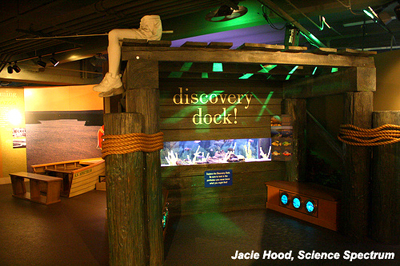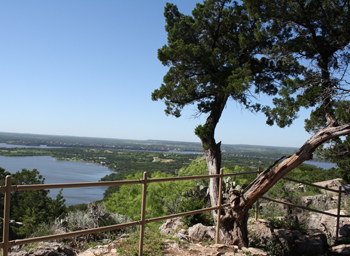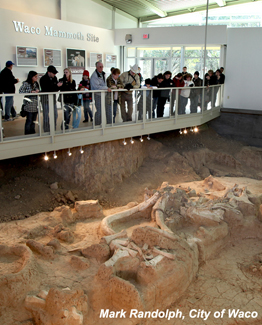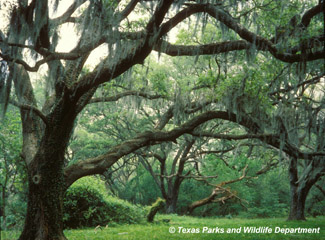Summer is here, and natural beauty can be found across the Brazos River basin. Did you know the region is also steeped in history that is just waiting to be explored?
Whether you are setting out for a vacation or just want a weekend away, we have you covered. From lakeside hiking trails and great fishing holes to frontier forts and
museums dedicated to Texas rock stars, the Brazos basin offers something for just about everyone.
UPPER BASIN
Lubbock: Texas music legends, historic ranches and science fun
Fairly close to the headwaters of the Brazos River one can find this city on the Texas prairie ready with plenty of fun things to do and see. Lubbock sits by the North
Fork of the Double Mountain Fork of the Brazos River, atop the Llano Estacado a few miles before it drops off the Caprock Escarpment.

A good starting point in this city that has been home to many renowned Texas musicians is the Buddy Holly Center. Named for the singer of such ‘50s hits as “Peggy Sue”
and “Not Fade Away,” this space for music and art exhibitions is centered on a museum for the town’s homegrown rock pioneer. Inside, you can explore everything from Holly’s stage clothing to
his record collection to the Fender Stratocaster guitar he played an hour before his tragic plane crash. Outside is a photo opportunity next to a giant replica of the musician’s signature glasses.
You can learn more about the center
here.
Nearby, you can journey down the Brazos and see examples of its diverse wildlife, without leaving the Lubbock city limits. "Texas Alive! The Brazos River Journey" in the
Science Spectrum Museum features more than 30 aquariums and terrariums with animals found in the Brazos basin. The critters range from rattlesnakes and snapping turtles to largemouth bass,
gar and even sharks and stingrays. Co-sponsored by Brazos River Authority, “Texas Alive!” is loaded with science and history activities. Hands-on interactive computer exhibits and video ranger
stations let you experience the sights and sounds of the river. The museum features many other science-related kid-friendly activities. To learn more about the museum and Brazos exhibit, please
click here.
Not too far away on the edge of the Texas Tech University campus sits the National Ranching Heritage Center. Here, visitors can learn about the hardscrabble lives of the
pioneers as well as the rise of the West’s great ranches. The museum features exhibits of both art and artifacts to introduce visitors to the history of ranch life. Outside, you can explore
more than 27 acres of historic structures brought together to show the evolution of ranching from the 1700s to 1900s. Many of these buildings were brought to the center from historic ranches.
For more, please click here.
Possum Kingdom Lake: hiking, fishing and camping opportunities abound

If you have never experienced the stunning hills, canyons and rock cliffs of Possum Kingdom Lake, this spring would be a great time. The lake features 16 acres of trails that
wind through the cedar-covered hills alongside the lake. The natural-surface trails are five feet wide and are accessible to hikers of a wide range of
abilities. One popular trail takes hikers to the top of Johnson Peak where one can get a 360-degree view of the surrounding lake and hills, as well as geological features such as the landmark
Hell’s Gate.
PK features 10 BRA public areas scattered across the lake’s central peninsula and on the west side. Nearly all are free year-round, and the two that charge during the
summer months call for a modest fee. The parks feature ample camping sites and offer a variety of amenities, including boat ramps, public restrooms with showers, fire rings and cooking grills.
New playground equipment has also been installed at a couple of the public areas.
Texas anglers also know the lake is also a good place to cast their lines. Among the varieties of fish you might hook are largemouth, striped and white bass; white crappie;
and channel and blue catfish. Many people also like to fish in the Brazos River just below Possum Kingdom’s Morris Sheppard Dam.
For additional information about recreation and the lake’s trails and public areas, please click
here.
CENTRAL BASIN
Waco: Take a hike, examine mammoth fossils and investigate historic Texas lawmen
If you’re traveling through Central Texas via Interstate 35, the city of Waco has several beautiful and interesting attractions that would make a
great stop.

Cameron Park is a scenic treasure that covers 416 acres of hills along the Brazos and Bosque rivers. The park’s limestone cliffs, with names like Lover’s Leap, tower more than
100 feet above the rivers and offer a breathtaking view of the surrounding countryside. Nearby, Cameron Park Zoo features the “Brazos River Country” animal exhibit, a re-creation of the Brazos
River’s regions, from the plains on the Caprock in West Texas to the mouth of the river at the Gulf of Mexico. The park’s trail system is also very popular. More than 20 miles of trails such as
like “Sidewinder” and “Act of Faith” meander through the park’s dense wooded areas and are well known among hikers and cyclists. For more information about Cameron Park, go to the website,
here. For more information about the zoo, call (254) 750-8400 or please click
here.
Just up the Bosque River from Cameron Park, you can visit the excavation site of a large group of Columbian mammoth remains. In 1978 two men searching for arrowheads and
fossils found a large bone sticking out of a ravine. Scientists identified the bone as belonging to a species of elephant that has been extinct for thousands of years. In the years since, workers
have excavated 22 mammoth fossils from what is the only recorded discovery of a nursery herd of the mammals. Also found in this spot was an extinct camel, part of a saber-tooth cat and another
unidentified animal. A public park at the 100-acre site opened in 2009. The park’s centerpiece is its dig shelter, which allows visitors to view the mammoth fossils from walkways suspended above,
inside a closed, lighted building. The park also features a walking trail and welcome center with a gift shop. For more information, call (254) 750-7946 or visit the website,
here.
Close to downtown, along the river, one can explore the history of the group of Texans who evolved from frontier lawmen to some of the most respected peace officers in the state
at the Texas Ranger Hall of Fame and Museum. Inside, you can find a wealth of historical artifacts tracing the history of the Texas Rangers as well as their depiction in popular culture. Visitors
can read about and see items belonging to legendary Rangers such as Francis (Frank) Hamer, who tracked down and helped ambush outlaws Bonnie and Clyde. The museum also memorializes those Rangers
who died in the line of duty and hosts a research center. Among the displays is memorabilia related to fictional Rangers such as the gun belt and prop pistols worn by Clayton Moore, television’s
“Lone Ranger.” And while you’re in the area, check out the best of Texas sports at the Texas Sports Hall of Fame just down the street. To learn more about
visiting the museum, please click here.
Fort Parker: Site of infamous Comanche raid
In Limestone County, on the edge of the Central and Lower Brazos basins, you can find the site of Old Fort Parker. This park, just north of Lake Limestone, gives
visitors the opportunity to experience life in the 1830s. The site is the location of an infamous Comanche attack on the area settlers. Here you will learn the story of the capture of the
Cynthia Ann Parker, who eventually adapted to the Comanche way of life and became the mother of the last great Comanche chief, Quanah Parker. If you want to take a break from exploring the
replica stockade fort and cabins, you can take advantage of the picnic areas, fire rings and primitive camping. For information about the park, fees and hours, visit the Old Fort Parker
Preservation in Limestone County by clicking here. You can also learn more about visiting the nearby BRA reservoir, Lake Limestone by clicking
here.
LOWER BASIN
Brazos Bend State Park: A great destination for alligator spotters and stargazers
Hiking is a popular pastime at this state park along the Brazos River south of Houston, and if you keep your eyes open, you might even spot an alligator or two. These once
endangered animals can typically be found in and around the park’s watery features. And don’t worry; according to the Texas Parks and Wildlife Department, no one has been injured by an alligator
at Brazos Bend. This is largely because people practice “alligator etiquette” tips posted on signs and maps around the park.

Brazos Bend features several trails ranging from short distances to several miles in length. Although most of the trails pass through the Brazos River floodplain, some also
go through a section of coastal prairie and wooded areas. The park features picnic and camping areas nestled among moss-draped oak trees. There is also a half-mile nature trail and
interpretive wetland exhibit. This paved trail includes interpretive panels with tactile bronzes of wetland wildlife and an observation deck for wildlife viewing as well as rest areas with
shaded benches.
Those whose interests tend to draw their gaze skyward might enjoy the telescopes at the park’s George Observatory. The facility features three telescopes and hosts regular
events such as an amateur rocket day and simulated space flight. The observatory is open to the public year-round on Saturdays. In addition it may be open on other days for special events.
To learn more about Brazos Bend State Park, please click
here. More information can be found about the George Observatory by visiting this
link.
Velasco, Surfside Beach and Quintana: History and fun in the sun come together
If you are looking to take in the sea and sand in a place steeped in Texas history, few locations rival the communities of Surfside Beach and Quintana at the mouth of the
Brazos River. The Gulf shore burgs sit on islands that frame each shore of the river. Those who enjoy the warm Gulf water and the many activities the towns have to offer might not realize the
area has played an important role since long before it drew tourists.

In 1821, the father of Texas, Stephen F. Austin, brought a group of colonists to the area. Austin went on to set up the town of Quintana at the behest of Mexican officials.
The area also saw some of the first fighting between independence-minded Texans and Mexicans in 1832. The commander of the Mexican Fort Velasco, also located in this area, unsuccessfully
challenged the Texans, before surrendering. In 1836, the war with Mexico formally ended, and independence began, with the signing of treaties at Velasco. During the Civil War, the Confederacy
set up a fort at Quintana, which came under shelling by the Union Navy. The area again saw artillery installed during World War II. Guns were placed in what is now the county park, in an effort
to protect important chemical plants upriver.
Though six hurricanes have struck the area, including the devastating 1900 hurricane and 2008’s Hurricane Ike, the area has long drawn people wanting to relax in its
beauty. Fort Velasco is long gone, but the city of Surfside Beach has a museum at the City Hall. The museum is open weekdays from 8 a.m. to 5 p.m. and features informational displays,
artifacts and models of the fort. Surfing, fishing and even bird watching is popular in the area. The communities also offer several shops and restaurants as well as hotels and rental
beach houses.
For more about Surfside Beach, and information about the City Hall, please click
here. For more information about Quintana, go
here.
It’s a great time to discover the fun and history Texas has to offer. We have you covered in the Brazos basin. 